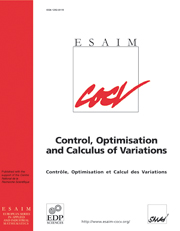Article contents
Epitaxially strained elastic films: the case of anisotropic surface energies
Published online by Cambridge University Press: 01 March 2012
Abstract
In the context of a variational model for the epitaxial growth of strained elastic films, we study the effects of the presence of anisotropic surface energies in the determination of equilibrium configurations. We show that the threshold effect that describes the stability of flat morphologies in the isotropic case remains valid for weak anisotropies, but is no longer present in the case of highly anisotropic surface energies, where we show that the flat configuration is always a local minimizer of the total energy. Following the approach of [N. Fusco and M. Morini, Equilibrium configurations of epitaxially strained elastic films: second order minimality conditions and qualitative properties of solutions. Preprint], we obtain these results by means of a minimality criterion based on the positivity of the second variation.
Keywords
- Type
- Research Article
- Information
- ESAIM: Control, Optimisation and Calculus of Variations , Volume 19 , Issue 1 , January 2013 , pp. 167 - 189
- Copyright
- © EDP Sciences, SMAI, 2012
References
- 10
- Cited by




